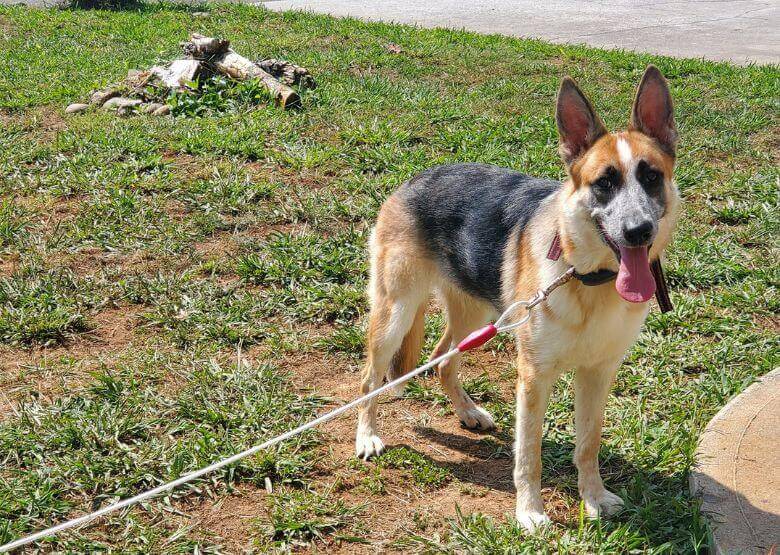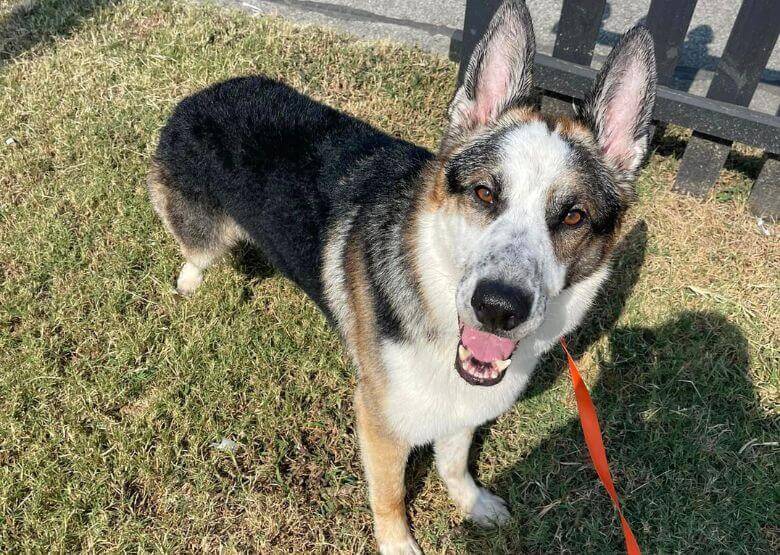Table of Contents
A Panda German Shepherd is a purebred dog for sure. It does not differ much in its temperaments and qualities from its black-and-tan counterparts. The only distinctive difference is the unusual color of the coat with black-and-white symmetrical markings on the body and especially around its eyes. These markings remind people of panda coloring. That’s why the name appeared, but it is sometimes called the Piebald German Shepherd.
A Panda GSD is a perfect match for experienced dog lovers, but it needs a lot of training. So, it may not be the best choice for first-time dog owners.
Because these dogs are quite rare, the Panda German Shepherd price is a bit higher than that of a common German Shepherd. You can pay about $1,500-$3,000 on average. Be sure that you buy your pet from a reputable breeder who can provide you with all the required documentation, including DNA testing for a puppy and its parents.
Consider that you should spend about $1,200-$1,500 per year for taking care of this dog. It involves immunization, neutering or spaying, feeding, accessories, and training.
We have compiled the main appearance and behavioral characteristics, exercising, feeding, health care needs, and training tips for this amazing dog. We hope that you will learn a lot of helpful things from this article.
History and Origins of Panda Colored German Shepherd
Like German Shepherds of other colors, Panda dogs trace their origin to Beowolf and its grandsire Horand von Grafrath. Beowulf was the father of about 100 puppies.
However, the first panda-colored German Shepherd was bred unintentionally in the United States in 2000. Cindy Whitaker received it from a black-and-tan father and solid black mother who were AKC-registered.
Though there were doubts about whether the panda dog was purebred, the DNA testing held by the AKC proved that it was.
The breeders noticed that the coloring is similar to the piebald one in other breeds. In 2016, UC Davis discovered the reason for this mutation. It was the KIT gene or Receptor Tyrosine Kinase (also sometimes called the Piebald Trait Protein) responsible for cellular growth and nerve function in the gut. The gene can also influence the pigmentation cells called melanocytes. White spotting is caused by their lack in certain areas of the coat.
Nevertheless, this mutation is dominant in GSDs. The gene is passed to about 50% of puppies in the litter. The white color is shown minimally on the tail, but forms a white ring on the muzzle, and is spread across the chest. It can also be a collar around the neck. The Panda gene can also produce lethality in its two copies that kill the embryo.
Some Panda Shepherds can have black-and-tan, solid black, blue, or liver as base colors. You can also encounter such mutations in liver and tans, blue and tans, and silver and tans.
Appearance and Characteristic Features
Typical Panda German Shepherd dogs look the same as their other counterparts, with possible differences in body shape. They are characterized by a large head with a slight dome-shaped forehead, big upright ears, and a strong muscular body and thick legs.
White fur is usually displayed on the muzzle, chest, belly, collar area, and the end of a tail on the basic black-and-tan coloring. Most Panda dogs tend to have 35% white on their coats.
The other characteristic features include strong bodies that are longer than their height, heads that are proportional to bodies, almond-shaped eyes, and strong nails on muscular and heavy feet.
Males are usually 24-26 inches (61-66 cm) tall, while females are a bit smaller – with a height of 22-24 inches (56-61 cm). Males weigh 75-95 pounds (34-43 kg) and females weigh 55-73 pounds (25-33 kg). The life span of these Shepherds is 9-13 years if they are properly fed and exercised.
A Panda Shepherd female usually has 6-10 puppies in a litter. Some of them can be fully white, and others may even be of a common GS color.
Apart from the unusual color, these dogs’ coat is medium-length. Though, there may be long-haired Panda German Shepherd dogs. These pups are double-coated with the upper coat that is much thicker and the underneath layer which is very soft.
You do not need any special efforts to maintain your pet’s coat. Just brush it once in several days and more frequently during their heavy shedding periods in spring and autumn.

Temperament and Behavior
Like other German Shepherds, Panda GSDs are intelligent, bold, focused, and confident. You need to be very confident too while training them because they need a leading influence, or they will start displaying disobedience.
Their characteristics are perfect for performing services in police, military, agility, tracking, guarding, herding, guiding, and Schutzhund. They can also become great family pets who are good to kids if socialized early and supervised properly.
These are high-energy dogs that need a lot of (about two hours daily) exercising. They also need continuous training and ongoing mental stimulation. Initially, a Panda German Shepherd puppy can display aggression toward other dogs and smaller animals as well as toward strangers if not properly socialized.
Panda Shepherds prefer to spend time with their owners and family. They suffer when left alone, so it may lead to some behavioral problems in the future.
When trained, the recommendations are to perform tracking, herding, agility, and dock diving with them to keep the animals physically fit and mentally energized.
Panda Shepherds are very smart and intelligent. They also have strong noses to sniff contraband, drugs, weapons, and dangerous intruders. They can bored quickly, so mental stimulation is a perfect method to avoid that. If not stimulated, they may become either timid or destructive.
These pups are very loyal to their owners and will fiercely protect them from intruders. If they are properly trained, they can distinguish between threatening and non-threatening intrusions, so they will perform aggression only if their owner is in trouble.
Panda dogs are pretty confident. They are always alert about their surroundings. Such a pup enjoys discovering new things and learning new experiences. The unique characteristic feature of these animals is that they can become very shy if their owner is not a confident leader. Such dogs are considered faulty according to canine standards. Their shyness can be a problem because, when frightened, they can display immense aggression toward other humans and animals.
Exercising and Training
The first question to ask yourself if you choose to acquire a Panda German Shepherd is whether you can deal with it. Remember that your potential pet is very energetic and curious. You will need to exercise and train it a lot, always challenging it with new tasks. When left on your own, this dog will get bored, frustrated, and even depressed. That can lead to heavy misbehavior or aggression in the future.
These German Shepherds hate staying alone at home. They cannot be too active inside, so think about whether you have time to walk and play with your doggy. Or, if you are planning to leave it for a long time, get prepared to see your home topsy-turvy.
Playing and exercising outside is a must for this Shepherd. You should run, jog, swim, and ride a bike with it for at least two hours per day. Or you can play fetch, frisbee, or joint games with other dogs. The only thing is that you need to monitor your dog and rule it properly when it is playing with other animals to ensure that it behaves properly.
You need a backyard or a nearby park for walks. However, if you are a first-time dog owner, you may not be confident about how to exercise and train your dog. That is why, if you insist on this breed, try to find puppy training classes. They will teach your pup the basic commands and socialization with other animals and people in a safe environment. Nevertheless, you will need to repeat all these training techniques regularly while outside these classes because your dog’s habits will form in this way. It can forget everything it was taught in the classes or not be able to transfer these skills to your home environment.
Panda GSDs are pretty intelligent, and they will do their best to please their owner. Reinforce your pet positively while training and give it rewards in the form of praise and treats. Your doggy will learn quickly what is acceptable and what is unacceptable for you. So, you will receive a properly behaving Shepherd soon if you are persistent enough.
Consistency is one more thing you need to practice in your relationships with your pet. Your reactions to its misbehavior should be the same all the time. For example, if your puppy is taught not to jump at people, tell your friends that they should not allow it to jump at them either, or your doggy can be confused with such different reactions.
If your little Shepherd misbehaves, your best reaction should be to ignore it. Never shout or punish it physically if you don’t want to evoke aggression in the future.
Socialization training is important for a Panda German Shepherd puppy from a very early age. It should be socialized with different people, other animals, little kids, strange objects, and changing locations. You may also take obedience classes with your puppy. They will teach it to be confident and structured in its behavior.

Feeding
Feed your panda-colored German Shepherd with high-quality dog food. It should include a lot of protein, fats, carbohydrates, and vitamins for better growth and more energy. If you buy the kibble, ensure that it contains at least 18-20 % of protein and about 5% of fat for adult animals and 22-25% of protein, and 8-10% of fat for young puppies.
Be very attentive when you choose the food. It can differ as specialized food for puppies, juniors, adults, and seniors. Such a diet has a great impact on your pet’s quality of life. If you feel that your budget is rather restricted, it is better not to get a German Shepherd because, if you choose low-quality food, your pet will suffer from numerous diseases soon, and you will have to spend a lot on veterinarian bills.
How much should you feed your doggy? Adults Panda German Shepherds consume from 3.5 to 5 cups of kibble per day. It is better to feed your dog twice per day, with continuous access to fresh water. Though, you should weigh your pet to check it in accordance with the weight chart. You may see that it is either overweight or underweight. In this case, talk to your vet. You may probably need to make changes to your doggy’s diet. Remember that how much your GSD eats depends on its age, size, and activity level.
Health Concerns
Like all other more traditional German Shepherds, this variety of dogs can suffer from certain diseases, including hip and elbow dysplasia, degenerative myelopathy, bloat, keratitis, and sometimes, epilepsy.
Degenerative myelopathy is a genetic disease that affects the spinal cord. It can lead to weakness in the hind legs and even paralysis. The first signs of this disease can display when the dog is 4 years old. However, when it is well-cared, you can observe them much later, at the age of 8-14 years old, or they will not show up at all.
Hip dysplasia results from poor growth of the ball and socket joints in the hips. Joints become loose, and the dog gets osteoarthritis which leads to lameness. This disease is, unfortunately, common in most large breeds with a weight of more than 22-23 kg. Apart from German Shepherds, it can also affect Golden Retrievers. It is also an inherited condition, however, you can minimize it with proper nutrition and exercise.
Bloat is a life-threatening condition characteristic of most big dog breeds with a wide chest. It results from the dog’s anxiety and eating very fast. The stomach twists and the blood cannot get to all the organs. The condition can be lethal, so it is strongly recommended to feed your pet in smaller portions twice a day to slow down the pace of eating and improve digestion.
Keratitis is an inflammation of the eye cornea. You will need special drops and ointments to treat it. If properly treated, it goes away in a week. Though, if ignored, keratitis can influence deeper layers of the eye and lead to blindness.
Epilepsy is a heavy brain disorder that results in severe seizures. It is not so common in Panda Shepherds. In general, it can affect only 0.75% of dogs. The disease is also genetic, or there may be some other stressful causes that provoke it. This condition whose roots are unknown is called idiopathic epilepsy. It is the most common disease in German Shepherds. You will need anti-epileptic drugs, such as potassium bromide or phenobarbital to treat the symptoms of this disease.

FAQ
Are Panda German Shepherds purebred?
Sure. These dogs are purebred. The DNA testing conducted by the AKC proved it. The unusual color is a result of the gene mutation but not of mixing breeds. Moreover, it cannot be considered a designer breed, either. These dogs have exactly the same characteristics as their counterparts of another, more traditional, color. They are also prone to the same health issues. However, you should be cautious while buying a Panda German Shepherd puppy and demand specific documentation about the little one and its parents from a reputable breeder.
Are Panda German Shepherds rare?
It seems that such panda-colored German Shepherds are rather rare. This is the rarest color of the coat in Shepherds. In fact, the fur is tricolor, but the large area of it is white. It is striking and looks very beautiful. The color is connected to the piebald gene, common in other dog breeds.
How big do Panda German Shepherds get?
German Shepherds, including panda-colored ones, belong to big dog breeds. Males grow as tall as 24-26 inches (61-66 cm) and females are 22-24 inches (56-61 cm) tall. The weight of males ranges between 75 and 95 pounds (34-43 kg), and females weigh 55-73 pounds (25-33 kg).
Final Thoughts
A Panda German Shepherd is a perfect dog with many great characteristics. It is intelligent, loyal, and confident. It can become a stunning companion and reliable family member. That is why these dogs are often used in the military and by police, or as caring guides for the blind.
However, getting such a doggy is not recommended to first-time owners and people who are not confident in their dog training skills. These pets need a lot of your time and energy, and you cannot leave them alone for a lengthy time. Your pet will need at least two hours of exercise every day, so be sure that you will have enough time for it.
If properly trained and cared for, a Panda GSD makes a great choice for every dog lover.
